
This page is part of © FOTW Flags Of The World website
Imperial Ethiopia (until 1975)
Last modified: 2025-04-19 by bruce berry
Keywords: ethiopia | lion | st. george | magen david |
Links: FOTW homepage |
search |
disclaimer and copyright |
write us |
mirrors
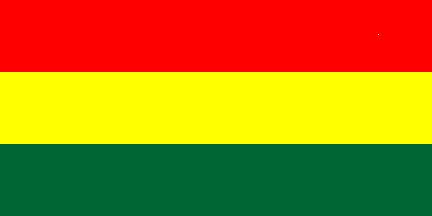 |
|
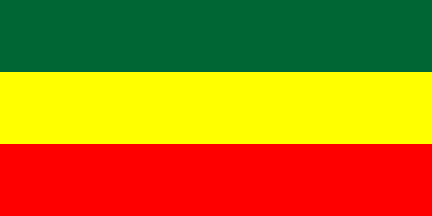
| images by Ivan Sache, 18 July 2000 |
| In use between 06 October 1897 and May 1936 |
|
In use between 05 May 1941 and 05 February 1996 with various defacements |
See also:
Background
Although East Africa, and more specifically the general area
of Ethiopia, is widely considered to be the site of the
emergence of early Homo sapiens, the Ethiopian culture we know today may be said
to date from between the 9th and 11th centuries. Judaism and Islam grew to be
powerful forces in Ethiopia. In the fourteenth century, Emperor Amda Siyon made
a serious effort at expansion, annexing territories and consolidating these into
an Ethiopia which more or less conformed to the boundaries of the country today.
To do so, he suppressed ethnic movements and firmly established Ethiopia as an
Amharic and Christian nation. He granted a form of autonomy to regional rulers
as his feudal vassals with authority over fiefs, and accommodated Islam.
Although contact was made with the Europeans during the 16th and 17th centuries,
Ethiopia maintained its independence during the Scramble for Africa when much of
the rest of the continent was colonised by the major European powers.
Ethiopia as we currently know it began under the reign of
Menelik II who was Emperor from 1889 until his death in 1913. Much of the
20th century was marked by the reign of Emperor Haile Selassie. It was he
who undertook the modernization of Ethiopia, from 1916, when he was made a
Ras and Regent (Inderase) for Zewditu and became the de facto
ruler of the Ethiopian Empire. Following Zewditu's death he was made Emperor on
02 November 1930.
The independence of Ethiopia was interrupted by the
Second Italian-Abyssinian War and Italian occupation (1936-1941) during
World War II when the country became part of
Italian East Africa (or Africa Orientale Italiana
in Italian) (AOI). The AOI consisted of Ethiopia and the colonies of Italian Somaliland and
Eritrea
and was held in the name of Victor Emmanuel III of the Kingdom of Italy.
Following the entry of Italy into World War II,
British Empire forces, together with patriot Ethiopian fighters,
liberated Ethiopia in the course of the East African Campaign in 1941.
This was followed by British recognition of full sovereignty with the
signing of the Anglo-Ethiopian Agreement in December 1944.
In 1952 Haile Selassie orchestrated the federation with
Eritrea which he dissolved in 1962. This annexation sparked the
Eritrean War of Independence which eventually culminated in it achieving
its independence from Ethiopia in 1993. Haile Selassie's reign
came to an end in 1974 when a Soviet-backed Marxist-Leninist military
junta (the Derg) led by Mengistu Haile Mariam deposed him, and
established a one-party state which was called the People's Democratic
Republic of Ethiopia.
In May 1991 the Mengistu regime came to an end following the fall of
communism in Europe and withdrawal of Soviet support. A new
Transitional Government of Ethiopia was set up and a new constitution
allowing for multi-party elections was established in 1994.
Bruce Berry, 11 Dec 2010
Imperial Ethiopian Flag (ca May 1941 - Sept 1974)
The flag used by the Empire of Ethiopia was a
horizontal tricolour of green, yellow and red. According to Whitney Smith
in Flags through the Ages and across the World (1975) [smi75b], prior to the
nineteenth century three pennants were used together as the national flag.
A rectangular flag (with red on top) was adopted on 06 October 1897 and the
change to the green stripe on top occurred in 1941 following the end of the
Italian occupation of the country.
The Emperor of Ethiopia was known as the "Conquering
Lion of Judah" and the imperial symbol featuring a lion was also sometimes added
to the centre of the flag. Smith (1975) [smi75b] says the flag featuring the lion
emblem is the state flag while the plain tricolour was the national flag.
The lion emblem was placed on the obverse and a symbol of the figure of St.
George slaying dragon was found on the reverse to symbolise the nation having
defeated its enemies.
There were a number of variants of the lion emblem as
illustrated below:
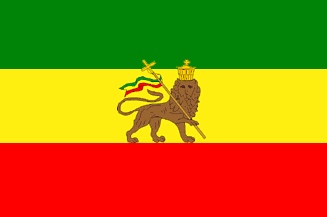 image updated by Antonio Martins-Tuvalkin, 12 July 2017
image updated by Antonio Martins-Tuvalkin, 12 July 2017
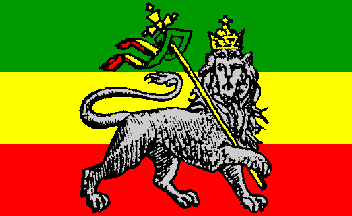 image by Jaume Olle,
06 Feb 1996
image by Jaume Olle,
06 Feb 1996
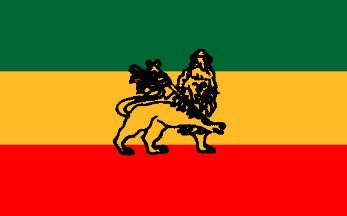 image
by BlinxCat, 01 June 2022
image
by BlinxCat, 01 June 2022
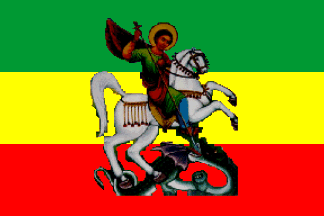 |
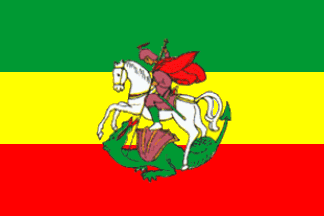 images by Yared Haile Selassie, 21 Aug 2004
images by Yared Haile Selassie, 21 Aug 2004
|
| (obverse) |
(reverse) |
In an atlas that I have from 1969, there is a flag chart, showing the Ethiopian flag with the golden crowned lion. It is reproduced here from the
now defunct Ethiopia
home page. The lion is golden and outlined
in black.
Željko Heimer, 12 June 1996
The North American Vexillological Association met in Trenton, New Jersey a few
years ago and the son of Haile Selassie (a local resident at that time) was invited to be our guest Dinner Speaker. Mr. Selassie was presented with a very nicely made reproduction of the Ethiopian flag with the Crowned Lion holding the flagstaff with the cross finial on the obverse and St George and the Dragon on the reverse. Mr. Selassie told us about the symbolism of the flag, and he stated that the Cross that the lion carried was a pre-Christian symbol. Since I was highly suspicious of this explanation, I asked him "If the cross on the Ethiopian flag is a Pre-Christian symbol, what does it represent?" Unfortunately I did not get a coherent answer, or at least not one that I could understand. IMHO the cross refers to the Coptic Christians. But that incident in Trenton does serve to remind me of the use of the cross in the Ethiopian flag during the Imperial era.
Nick Artimovich, 12 June 1996
Mr. Selassie may have been confused or it may have been deliberate obfuscation and superstition (which I have occasionally noted in ancient cultures as they seek to legitimize their antiquity). Imperial Ethiopia claimed direct descent from King David of Israel (hence of the Lion of Judah in the flag and in the emperor's title), but these pre-Christian symbols apparently mingled with Christian ones pretty early in the history of the Christian church.
T.F. Mills, 12 June 1996
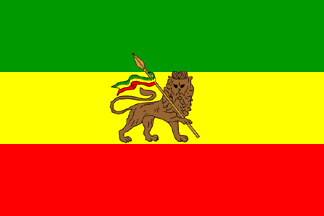 image
by Ċ½eljko Heimer, 06 June 1996
image
by Ċ½eljko Heimer, 06 June 1996
The State flag was modified after Haile Selassie's overthrow (12 September
1974) by removing the crown from the lion's head and by changing the Cross
finial to a Spear point. This version lasted only a few years until the
Socialists took over and radically changed Ethiopia's symbols.
Nick Artimovich, 12 June 1996
The lion is the old emblem of the emperor, and was part of the first Ethiopian flag hoisted on
06 October 1897, but then the order of the colours were red over yellow over
green.
However, one should consider that Smith states that the pure green-yellow-red flag is used by civilians on land and sea (when his book was issued Ethiopia still included Eritrea and its coast on the Red Sea). He does not mention what kind of flag the government or army uses.
Željko Heimer, 06 June 1996
At the College of Arms (UK)
website, an article on Haile Selassie says:
"On his appointment to the Order of the Garter in 1954 the Emperor at
first asked that he be allotted two stalls in St George's Chapel, one
for him as Emperor of Ethiopia, and the other for him as The
Conquering Lion of the Tribe of Judah."
and continues
"A compromise was reached and he accepted one stall but with the banner
hanging above it having different devices on either side to represent his
dual status."
It would be interesting to find out what those devices were.
However, it may be similar argument to why the old Ethiopian flag had two sides, one with a
lion and one with the dragon.
Nathan Lamm and Santiago Dotor, 20 May 2004
Imperial Standard
H.I.M Haile Selassie I Personal Standard
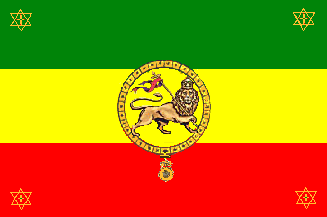
|
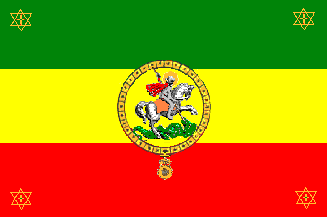 images by David Cox, 15 Aug 2004
images by David Cox, 15 Aug 2004
|
| (obverse) |
(reverse) |
Emperor Haile Selassie died on 27 August 1975 and was buried
privately beneath his office at the National Palace. His remains were
disinterred on 07 February 1992 and his coffin remained in Bhata Chruch for
nearly a decade. The Ethiopian Orthodix Church gave him a public burial on
05 November 2000.
These images are based on pictures of the funeral of his late Imperial Majesty,
pictures of the Order of Solomon's Seal,
and 1930's gold Ethiopian coin showing St George facing east, (similar to the
British sovereign). As Haile Selassie introduced the collar to the regalia of
the Order of Solomon's Seal (bringing it in to line with European practice), I
would suggest that this standard is unique to Haile Selassie and his heirs.
The Ethiopia tricolour, with the Lion of Judea on one side and St George
slaying the dragon on the other, each encircled by the collar of the Order of
Solomon's Seal, in each corner of the standard the badge of the order (a Star of
David with a cross).
David Cox, 15 August 2004
War Ensign (Blue Ensign)
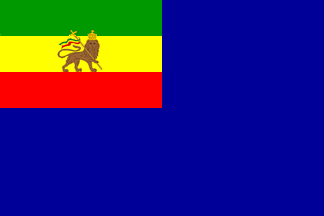
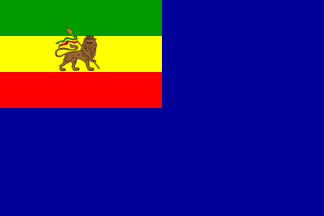 image by images by António Martins-Tuválkin, 17 Dec 2024 and David Cox,
15 Aug 2004
image by images by António Martins-Tuválkin, 17 Dec 2024 and David Cox,
15 Aug 2004
Imperial Ethiopia used a British-style blue ensign with the Ethiopian state flag in the canton. This was the familiar green-yellow-red tricolour with the addition of the Lion of Judah holding a staff with a Christian cross on the end and the tricolour as a banner. Christian Fogd Pedersen [ped70] states that this ensign was 'Modelled on the
British Blue Ensign' but gives no further details.
Stuart A. Notholt, 11 February 1996
Like the State flag, the ensign was modified after Haile Selassie's overthrow (12 September 1974) by removing the crown from the lion's head and by changing the Cross finial to a Spear point.
Jaume Ollé, 06 Feb 1999












